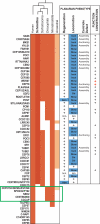Centrosome loss in the evolution of planarians
- PMID: 22223737
- PMCID: PMC3347778
- DOI: 10.1126/science.1214457
Centrosome loss in the evolution of planarians
Abstract
The centrosome, a cytoplasmic organelle formed by cylinder-shaped centrioles surrounded by a microtubule-organizing matrix, is a hallmark of animal cells. The centrosome is conserved and essential for the development of all animal species described so far. Here, we show that planarians, and possibly other flatworms, lack centrosomes. In planarians, centrioles are only assembled in terminally differentiating ciliated cells through the acentriolar pathway to trigger the assembly of cilia. We identified a large set of conserved proteins required for centriole assembly in animals and note centrosome protein families that are missing from the planarian genome. Our study uncovers the molecular architecture and evolution of the animal centrosome and emphasizes the plasticity of animal cell biology and development.
Figures



References
Publication types
MeSH terms
Substances
Grants and funding
LinkOut - more resources
Full Text Sources
Other Literature Sources

